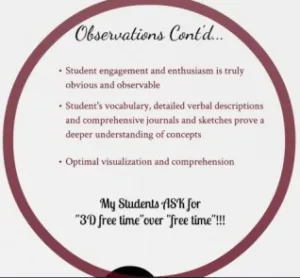
Quick Search: Research is a new series dedicated to unpacking some of the emerging research on 3D, VR, and other dynamic visualization technologies. Refer to the introductory article for this series, entitled Chasing the Research. In today’s article, we are highlighting some informal, classroom-based “action research” effort conducted in a Minnesota elementary school.
*****
One of first questions people ask me about 3D (and sometimes VR and even HD visualization technologies) concerns its instructional effectiveness, based on available research. “What is the difference some of these technologies make in learning?” “How effective are these technologies with young learners?” they ask. “Action research”, as it is called, is informal research conducted in live classrooms by practicing teachers. It can provide very useful empirical insight about learning with technology. Here’s one story worth noting.
The Problem.Holli HillmanHolli Hillman, a 4th grade teacher in the St. Francis Schools (Minnesota) knew that her new 3D visualization technology was having an impact on young learners, but she needed a way to demonstrate that learning effectiveness to the leaders who funded her classroom grant. Accountability was expected. Ms. Hillman decided to conduct a focused action research effort, showing before and after examples of actual student work.
The Backdrop.
For her project, Ms. Hillman used stereo 3D projectors, along with science simulation content in her fourth grade classroom over several years. Typically, she used age-appropriate parts of 3D simulations, but would mute the software, providing her own personal voice as narrator. Ms. Hillman would have the children watch each simulation—regularly pausing the simulations for timely discussion, comments, and questions—and then have the students watch the simulation again to allow for optimal comprehension.
The Discovery.
In her effort to create a before and after perspective, Ms.Hillman explains the protocol she followed:
I taught the water cycle using books, posters and discussions; kids were then asked to draw their visual understanding of the water cycle. A few months later, I completely retaught the water cycle using the stereo 3D simulations only (not the books and posters.) Again I asked the kids to draw their visual understanding of the water cycle.
Through her action research, Ms. Hillman wanted to compare the two treatments. How did the children fare? See for yourself:
Water Cycle Before 3D
Water Cycle After 3D
Before
After
After
The Lesson Learned.
The evidence of this informal action research gives us a little insight as to how 3D learning actually works in a classroom. Perhaps one fourth grader described it best: “you can picture it in your head better.” Ms. Hillman beamed: “the visualization is so rich that it provides an experience unlike anything you can provide through teacher talk, or even hands-on investigation.” She added : “[3D simulation] takes students on virtual field trips to places they would otherwise never be able to go; the color, imagery, and the depth is attractive and captivating.” Additional findings from this informal study are highlighted below:
Holli Hillman asks the reader a rhetorical question: “The difference in visual understanding speaks for itself, right?” Right. –Len Scrogan

